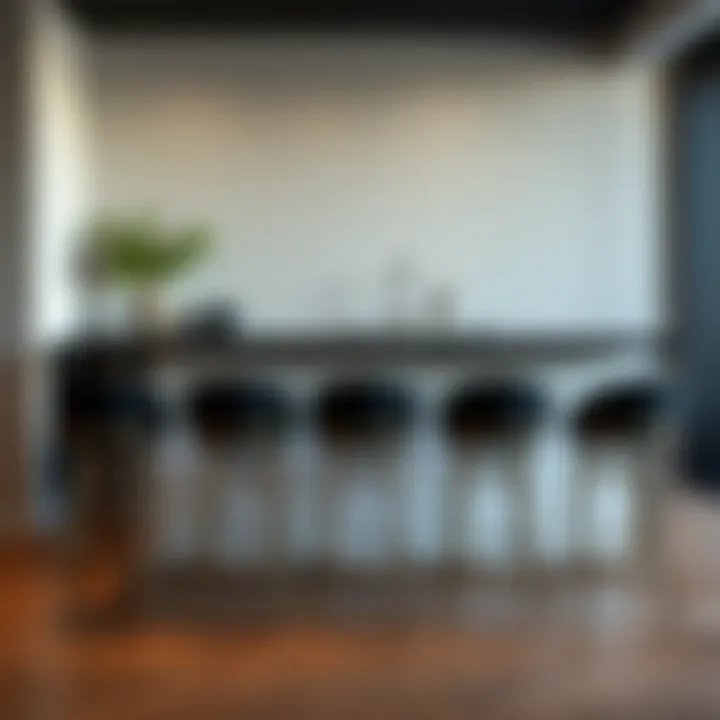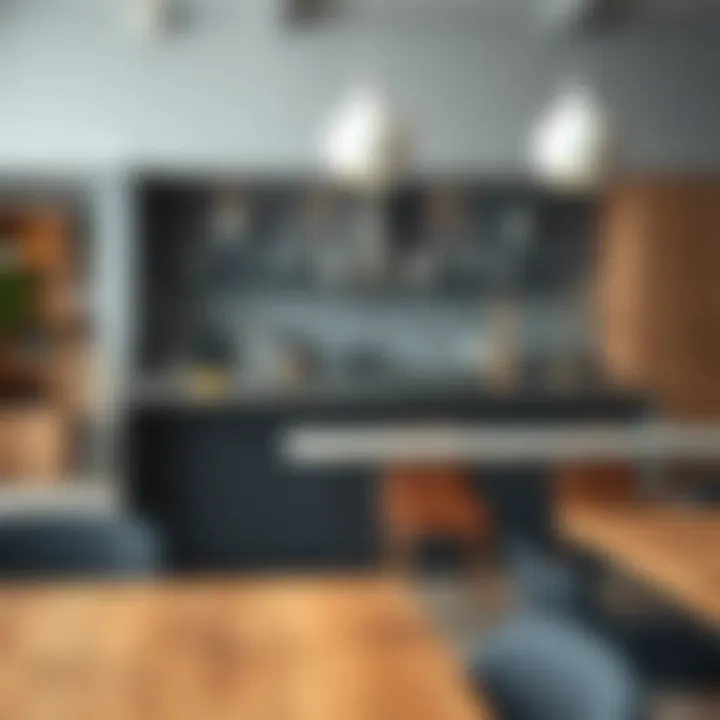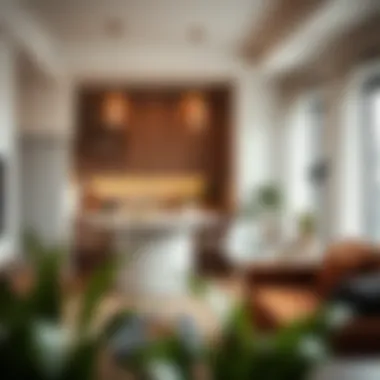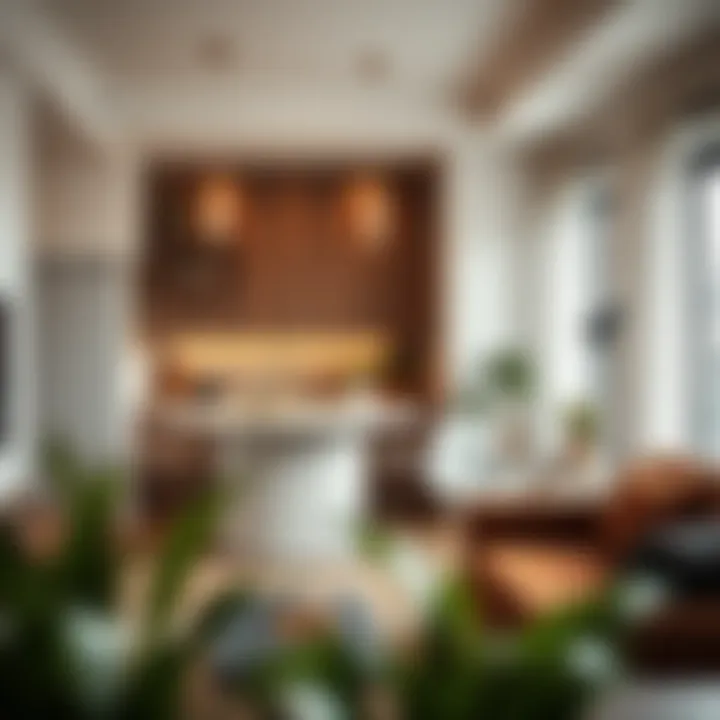Exploring Modern Breakfast Bar Tables: Design and Functionality


Intro
In today’s fast-paced world, the breakfast bar table has carved out a significant niche in modern homes. An evolving symbol of casual dining and a snazzy centerpiece, this furniture piece marries functionality with style. For homeowners and design enthusiasts alike, understanding the intricacies of breakfast bar tables is key to optimizing their living spaces. By dissecting the trends, materials, and design principles surrounding these tables, we aim to provide practical knowledge that can influence both aesthetic choices and functional applications.
The breakfast bar table isn't just about where to take your morning coffee. It serves as a versatile hub for social interactions, meal preparations, and even a makeshift workspace during busy weekdays. With materials ranging from sleek metals to warm woods and innovative designs that reflect personal style, selecting the ideal breakfast bar table becomes less of a chore and more of an exciting creative endeavor.
As we unfold the layers of this topic, we will touch on trending furniture styles, color palettes that complement modern sensibilities, and practical design tips that anyone can integrate into their home.
Current Furniture Trends
Popular Styles and Materials
In recent times, breakfast bar tables have shifted toward open, airy designs that prioritize minimalism while offering flexibility. Many contemporary pieces boast clean lines, geometric shapes, and a diverse range of materials:
- Natural Wood: The raw appearance of reclaimed wood holds a strong allure. Many homeowners find beauty in its imperfections, making every piece unique.
- Industrial Metal: Stainless steel and wrought iron tables add an urban edge that harmonizes with loft-style apartments or rustic kitchens.
- Glass: Sleek and modern, glass-topped tables bring an element of lightness while ensuring that the focus remains on the surrounding decor.
Having a variety of styles allows homeowners to match their breakfast bar table with personal preferences and existing interiors, whether leaning towards a rustic farmhouse feel, a sleek contemporary vibe, or something eclectic.
Key Color Palettes for Modern Spaces
Color plays a pivotal role in setting the mood of any space. For breakfast bar tables, neutral tones are trending, as they create a calm and welcoming atmosphere. Key palettes include:
- Soft Beige and Cream: These shades evoke warmth and can blend seamlessly with various decor themes.
- Charcoal Gray and Black: Providing a striking contrast against lighter walls or cabinets, these colors add sophistication.
- Pastel Shades: Light blues or soft greens can introduce a refreshing twist to common color schemes, perfect for creating a more inviting kitchen.
Whether you're revamping a single corner of your kitchen or constructing an open plan, choosing the right color for your breakfast bar table enhances the aesthetic flow without overwhelming the space.
Choosing the right material and finish can make a world of difference in how your breakfast bar table complements your home design.
Practical Design Tips
Space Optimization Techniques
In bustling homes, every square foot counts. Breakfast bar tables can enhance space efficiency, especially in smaller kitchens. Here are a few techniques to consider:
- Multi-functional Designs: Look for tables with built-in storage or those that can double as work surfaces for meal prep.
- Wall-Mounted Options: If floor space is tight, consider a foldable wall-mounted table. This can be tucked away when not in use for a clutter-free look.
- Use of Bar Stools: Opt for stools that tuck under the table to keep the area tidy. Adjustable height stools are a plus, accommodating various user preferences.
DIY Projects for Custom Furnishings
For those who fancy a hands-on approach, creating your own breakfast bar table can be rewarding and cost-effective. Here are a couple of project ideas:
- Repurposed Wood: Gather old wood flooring or pallets and sand them down to create a rustic table top. Add sturdy legs to finish it off.
- Painted Bar Table: Buy an inexpensive table from a thrift store and give it a fresh coat of paint. Choose colors that bring out the existing elements of your kitchen for a cohesive look.
By embracing these design tips, homeowners can transform their breakfast bar tables into functional works of art that enhance both dining experiences and overall aesthetics.
Prolusion to Modern Breakfast Bar Tables
In today's fast-paced world, the breakfast bar table has emerged as a pivotal fixture in modern homes. It is not just a place for meals; it embodies a lifestyle choice that champions convenience and sociability. With varying styles and functionality, breakfast bars cater to the diverse needs of homeowners, designers, and anyone keen on maximizing their living spaces.
Defining the Breakfast Bar Concept
At its core, the breakfast bar table serves as both a dining area and a social hub. Unlike traditional dining tables that tend to occupy considerable space, breakfast bars are designed to fit snugly within modern layouts. They can adapt to various scenarios—from quick breakfasts before work to casual gatherings with friends. The versatility allows families and individuals to enjoy meals without formalities, making daily dining more inviting.
In practical terms, breakfast bars can be a countertop extension connected to the kitchen or a standalone table with stools. This distinct arrangement caters to family members and guests alike, enhancing interaction during mealtimes. Homeowners often find themselves gravitating towards these spaces because they promote a relaxed atmosphere where conversations can flow freely.
Historical Context and Evolution
The evolution of the breakfast bar is deeply rooted in changing lifestyles. In the mid-20th century, homes in post-war America began embracing open-concept designs, thereby altering the way people engaged with their living spaces. Kitchens went from being hidden away to becoming central to the home experience. The introduction of the breakfast bar was a response to this transformation, offering homeowners a way to blend cooking, dining, and socializing seamlessly.
Initially, breakfast bars were quite simple—often just a few stools positioned around a counter. However, as tastes evolved and the demand for style and functionality grew, so did the designs. They now come in various forms and materials, reflecting personal tastes and complementing broader interior designs. From quaint wooden bars to sleek metal frames, the breakfast bar has become a canvas for self-expression, while also serving the practical need for space-efficiency within modern households.
"Design is not just what it looks like and feels like. Design is how it works." – Steve Jobs
As we explore further sections of this guide, we will delve into the characteristics, benefits, and trends that solidify the breakfast bar’s role in contemporary home settings. The insights gained will be valuable for anyone looking to make informed decisions about incorporating a breakfast bar into their own spaces.


Design Characteristics
When delving into the world of breakfast bar tables, it's crucial to recognize the design characteristics that set them apart. These attributes not only define their aesthetic appeal but also enhance functionality in diverse living spaces. A well-thought-out design can transform a simple table into the heart of a home, where meals are enjoyed and conversations thrive.
Material Selections
The materials used in breakfast bar tables play a pivotal role in their overall look, durability, and functionality. A savvy selection can cater to various tastes while meeting practical needs.
Wood
Wood is one of the most traditional yet popular choices for breakfast bar tables. Its natural beauty and warmth impart an inviting atmosphere to any home. A key characteristic of wood is its varied graining and hues – from rich mahogany to lighter oak – that can complement different design themes.
The unique feature of wood lies in its ability to absorb sounds, creating a warm, cozy environment. However, wood can be sensitive to moisture and temperature changes, making it essential to care for it properly. In this article, wood serves as a perfect example of a medium that beautifully merges functionality with style, though care must be taken in maintenance.
Metal
Metal offers a contemporary edge that many homeowners appreciate today. Its robust nature provides durability, making it resistant to wear and tear. The sleek, clean lines of metal design contribute to a modern aesthetic that often pairs well with minimalist settings.
A standout benefit of using metal is its versatility; it can adapt to various styles, from industrial to ultra-modern. However, it can be cold to the touch and might require additional cushioning such as a design with upholstered seats. Still, metal’s long-lasting qualities make it a wise investment.
Glass
For those looking to achieve a lighter, airier feel in their space, glass breakfast bar tables can be a stellar choice. The transparency of glass helps create an illusion of more space, which is especially advantageous in smaller areas.
One of the beneficial aspects of glass is its ability to add a sophisticated touch while being easy to clean. However, it’s important to note that glass may not be the best option for households with young children due to its fragility. Thus, exploring glass as a material can offer both beauty and practicality, yet caution is needed.
Composite Materials
Composite materials have gained traction due to their incredible flexibility and affordability. Often made from a blend of materials, composites can mimic the appearance of wood or stone without the hefty price tag. The key characteristic is their ability to withstand the rigors of daily use while remaining lightweight and easy to move.
For individuals keen on sustainability, many composite materials are also eco-friendly, which adds another layer of appeal. However, a potential downside is that they may not have the same longevity as natural materials. Aligning composite materials with the right design can yield positive results while maintaining budget-friendly solutions.
Style Variations
The variety of styles available in breakfast bar tables allows for personal expression and can dramatically impact the ambiance of a room. Each style brings its unique flavor, making it easier to find a match for personal aesthetic or overall home decor.
Industrial
The industrial style is characterized by raw materials like metal, wood, and exposed design elements. This style is excellent for those wanting to create a vintage or urban feel in their kitchen or dining area. Often featuring an unfinished look, industrial tables add a rugged charm.
Additionally, they are usually sturdy, making them perfect for high-traffic areas. One challenge might be their tendency to clash with softer design elements if not balanced well, but when done right, they can be striking focal points.
Minimalist
Minimalist designs are all about simplicity and functionality. The focus here is on clean lines and a clutter-free appearance, making these tables an ideal choice for modern homes where space is at a premium. Minimalist breakfast bars typically make use of high-quality materials without excessive adornment, emphasizing practicality.
The beauty of this style lies in its elegance and the ability to blend seamlessly into any surrounding. However, for some, the simplicity might feel stark or lacking in personality.
Retro
If it's nostalgia you're after, retro-style breakfast bar tables could be your go-to. With their bright colors and playful designs, they evoke a sense of fun and warmth reminiscent of times gone by. This style tends to capture the spirit of the 50s or 60s, offering cheerful appeal.
While they can serve as eye-catching centerpieces, retro tables might not fit a modern or minimalist environment. However, for those wanting to add flair, they can deliver just that.
Eclectic
An eclectic breakfast bar table draws inspiration from various design periods, combining different styles, textures, and colors. This style encourages individuality, allowing homeowners to highlight personal stories through curated pieces. The charm of eclectic design lies in its uniqueness, with the ability to infuse character into any space.
One possible downside is that the mix-and-match aspect can sometimes result in a chaotic appearance if not thoughtfully executed. Yet, when harmonized, eclectic designs can create vibrant and personalized spaces that resonate creativity.
Functional Benefits
The functional benefits of breakfast bar tables extend far beyond mere aesthetics. In an age where maximizing each square foot of living space is more crucial than ever, the breakfast bar table presents a versatile solution. This section will explore how these tables not only save space but also facilitate various dining experiences, solidifying their place in contemporary homes.


Space Optimization
Maximizing Small Spaces
When dealing with limited square footage, utilizing every inch wisely is essential. Breakfast bar tables are an ingenious way to maximize small spaces without sacrificing style or function. These tables typically create a compact eating area that doubles as extra surface space for meals or work tasks. A notable characteristic of such tables is their ability to fit snugly against walls or in corners. This versatility makes them a popular choice among urban dwellers and those living in smaller homes.
The unique feature of breakfast bar tables lies in their height and design. Many models are taller than standard dining tables, allowing for adjustable seating options like bar stools. This not only complements a more casual dining vibe but also gives the illusion of roominess, making the space feel larger than it actually is. However, a potential drawback to consider is the need for suitable seating; not all stools fit comfortably under the bar, so a little planning is essential to ensure comfort.
Creating Multi-Functional Areas
Creating multi-functional areas is a hallmark of modern design, and breakfast bar tables play a significant role in this trend. These tables serve as more than just a breakfast spot; they can function as an informal workspace, a study area for kids, or even a social hub for guests. This adaptability is a key characteristic that makes breakfast bar tables incredibly enticing.
One of the unique features contributing to this multi-functionality is their height. With the right seating arrangement, they can transform from a dining area to a casual workspace in a pinch. This is especially advantageous for families with varied schedules who need flexible spaces that adapt to changing needs. A downside could be the loss of formal dining rituals; families used to more traditional settings might find it difficult to adjust to a less conventional way of dining.
Facilitating Informal Dining
Breakfast bar tables are not just about fitting into small spaces or serving multiple purposes; they also bring a sense of casualness to dining experiences. In many households today, the idea of a sit-down dinner has evolved. These tables encourage informal gatherings, where cooking and dining can blend seamlessly with conversation and relaxation. This atmosphere can make meals feel less like a chore and more like a shared experience, inviting both family and friends to linger longer than they might at a formal dining setting.
The ease of movement is another facet of this informal dining experience. Breakfast bars allow for easy flow in a room, as people can simply stand or move around while interacting. Additionally, it opens up the kitchen space, making it feel less isolated and more integrated into the home’s overall layout. While this setup might lack the traditional feeling associated with a formal dining room, it emphasizes comfort and connection, which some may value more.
"In a world where every inch matters, embracing the multi-faceted design of breakfast bars can lead to more interactive and inviting spaces."
Through understanding these functional benefits, homeowners and designers can better appreciate the role that breakfast bar tables play in modern living. It’s not just about furnishing your space; it’s about creating an environment that reflects both style and functionality.
Integrating Breakfast Bars into Home Design
Integrating breakfast bars into home design is more than just a stylistic choice; it’s a practical decision that impacts the functionality and flow of living spaces. Breakfast bars fulfill a unique role, providing a dedicated eating area while acting as a sociable hub in the home. They can transform a dull corner into a vibrant focal point where families gather for casual meals or quick snacks.
To efficiently harness the potential of breakfast bars, homeowners should consider several key elements:
- Flow of Movement: Positioning the breakfast bar correctly within the space can enhance movement. It’s crucial to ensure that the area around the bar is not congested, allowing for easy access and social interaction.
- Natural Light: If possible, siting the breakfast bar near windows or areas with ample natural lighting can create an inviting ambiance, making the space feel more open and welcoming.
- Harmony with Design Elements: The bar should align with the overall theme of the home. Consider colors, materials, and textures that echo throughout the rooms for a cohesive look.
Positioning within Open Floor Plans
In modern homes, open floor plans have gained significant popularity, allowing for fluid transitions between spaces like the kitchen, dining area, and living room. Positioning a breakfast bar within an open layout can effectively delineate areas while preserving a sense of openness.
Key considerations for positioning include:
- Central Hub: Placing the bar centrally can invite conversation and keep everyone connected, whether it’s family members or guests entertaining.
- Dining Proximity: Keep the bar close to the kitchen for quick meal prep and serving. It can serve as an extension for food layout or drinks, minimizing trips back and forth.
- Visual Anchoring: Use the bar to anchor visual lines in the space, perhaps aligning it with a coffee table or sofa across the living area.
These strategies can enhance both design and functionality, creating an integral part of the living experience.
Complementing Existing Furniture
A breakfast bar should not just stand alone; it should complement the existing furniture in the home to create a harmonious environment. Careful selection of height, style, and material is necessary to ensure that the breakfast bar enhances rather than clashes with other elements.
Here’s what to keep in mind for effective complementing:
- Material Matching: If your dining table is made of reclaimed wood, opting for a breakfast bar with similar rustic elements can unify the theme.
- Functional Heights: Ensure that the height of the bar aligns well with other seating in the area. A counter height bar might match well with standard dining chairs, creating a seamless transition.
- Color Palette: Choose colors for the bar that tie back into the room's overall scheme, whether by direct matching or subtle contrast.
Employing these tactics can introduce a fresh flow to the room while maintaining a cohesive aesthetic.
"In design, complexity must be balanced by simplicity. A breakfast bar is no exception; it should reflect the overall story of the home while serving its unique purpose."
In summary, integrating breakfast bars thoughtfully into home design can elevate spaces, create sociable nooks, and enhance practicality. By understanding the dynamics of open spaces and the need for cohesion in furniture, homeowners can create an environment that is both stylish and functional.
Choosing the Right Breakfast Bar Table
When it comes to selecting a breakfast bar table, the options can be as vast as the ocean. It's not merely a matter of aesthetics; it's about finding the perfect balance between size, height, style, and functionality. The breakfast bar serves as a gathering spot, a work area, and often, a quick dining option. Therefore, making an informed choice not only enhances your space but also elevates your daily routine.
Considerations for Size and Height
Choosing the correct size and height of your breakfast bar table is essential, especially in homes with limited space. A table that’s too large can make a room feel cramped, while one that’s too small might seem lost in vastness. It's like trying to fit a square peg in a round hole; it just doesn’t work.


- Evaluate Your Space: Begin by measuring the area where you plan to place the table. Consider factors such as nearby walls, existing furniture, and foot traffic. Ensure there's enough room for chairs or stools, with at least 30 inches of clearance around the table to avoid any crowding.
- Height Considerations: Typical breakfast bars are around 30-36 inches tall, suitable for standard dining chairs or bar stools. If your space is on the cozy side, opting for a lower table might make it more accessible and inviting. Additionally, ensure that the seating height aligns with the table.
- Table Width and Length: A standard bar table is often about 24-30 inches wide. For length, think about how many people you want to accommodate. A table about 60 inches can easily seat four; if you go larger, remember to keep the flow throughout your room intact.
"Investing in the right breakfast bar table means taking into consideration your daily needs and the overall design of your space. It's about creating a balance that feels welcoming yet functional."
Balancing Style and Functionality
When your breakfast bar table stands as a centerpiece, it must do more than just look pretty. It should harmonize with your home’s aesthetic while ensuring practicality. Here are a few pointers on achieving this balance:
- Material Choices: Wood often exudes a warm, inviting feel that matches with various styles, from rustic to modern. Metal, on the other hand, provides a sleek, industrial vibe. Think about what complements your existing decor.
- Color and Finishes: Light colors can make a small space feel larger, while darker shades can add warmth. Experiment with finishes—glossy tables reflect light and seem modern, while matte options can appear more subdued and cozy.
- Functional Features: Look for tables with added storage options, like shelves or drawers. This way, you're not just looking at a table but a place to stow away items like utensils or cookbooks when not in use.
Ultimately, the key to a successful breakfast bar table is integrating both style and utility, crafting a piece that feels at home in its environment while serving your daily needs.
Trends Influencing Breakfast Bar Design
In the landscape of interior design, trends come and go like the tide. However, some shifts seem to carve a niche and resonate profoundly with homeowners seeking to blend functionality and style. The modern breakfast bar table is no exception, and its design has evolved with various trends that impact not just aesthetics but also utility. Awareness of these trends is vital as they offer a framework for creating spaces that are not only visually pleasing but also practical in everyday life.
One of the foremost trends in modern breakfast bar design is the increasing focus on sustainability. People are becoming more conscious of their environmental footprint, so many are turning to materials that minimize harm to the planet. This shift is reflected in consumers’ choice of environmentally friendly products, such as reclaimed wood, bamboo, or recycled metal. These materials not only reduce waste but also add a unique character that factory-produced items may lack.
Moreover, sustainable practices extend beyond the materials used. Many designers are now prioritizing energy-efficient manufacturing processes and suppliers who practice ethical sourcing. Homeowners are more inclined to invest in items that reflect a commitment to sustainability, making this trend both a personal and ethical choice.
Another significant trend shaping the breakfast bar's evolution is customization. In a world where individuality reigns, the ability to tailor designs to fit specific needs is paramount. From selecting unique finishes and colors to configuring shapes and sizes, customization allows homeowners to craft a breakfast bar that resonates with their personal tastes and spatial constraints.
The rise of online retailers and bespoke furniture makers has empowered consumers to envision and create their breakfast bar tables from the ground up. Options such as height adjustability, integrated storage solutions, or adding technology features like USB ports are increasingly popular. This personalization doesn’t just enhance usability; it fosters a deeper connection between the homeowner and their living space.
"Customization gives individuals the chance to echo their lifestyle and preferences through their furniture choices, making the breakfast bar not just a piece of furniture, but a representation of their identity."
In summary, the trends that influence breakfast bar design today emphasize sustainability and customization, reflecting a broader move toward mindful living and personal expression in home design. These evolving preferences are pivotal for anyone involved in the design process, providing pathways to create truly unique and meaningful spaces. As we delve deeper into the specifics of these trends, it becomes evident that they not only elevate aesthetic appeal but also cater to modern living's practical demands.
Practical Maintenance Tips
When it comes to breakfast bar tables, practical maintenance plays a crucial role in ensuring longevity and keeping those stylish surfaces looking fresh. A well-cared-for table not only enhances the aesthetic appeal of your space but also protects your investment. Engaging with upkeep can prevent wear and tear before it becomes noticeable.
Cleaning and Care Guidelines
Regular cleaning is key to maintaining the charm of your breakfast bar. Here are several tips to keep in mind:
- Dust Daily: Use a soft microfiber cloth to wipe down surfaces. This prevents dust buildup that can scratch finishes over time.
- Spill Management: Address spills immediately to avoid stains. For most surfaces, a damp cloth with a bit of mild soap can do wonders. Avoid harsh chemicals that could damage the finish; they can lead to discoloration and dullness.
- Seasonal Deep Clean: Depending on use, consider giving your breakfast bar a thorough clean every few months. For wood tables, a specialized wood cleaner can provide extra nourishment. For metal, a gentle polish can enhance its shine and prevent rust.
"An ounce of prevention is worth a pound of cure."
Repairing Common Damages
No matter how diligent you are with maintenance, mishaps can happen. Here are some common issues and simple fixes:
- Scratches on Wood: Use a wax crayon that matches the wood color to fill in scratches. Rubbing some olive oil or beeswax can also help blend imperfections.
- Water Rings: A paste of baking soda and water can be applied to rings caused by glasses. Gently buff it out and wipe clean.
- Dents in Surfaces: For minor dents, placing a damp cloth over the area and lightly steaming it with an iron can raise the wood fibers.
Remember, a bit of care goes a long way towards preserving the beauty and functionality of your breakfast bar table. Address any issues promptly to keep your dining space inviting and enjoyable.
Culmination
Understanding the role of the modern breakfast bar table is crucial in appreciating its place within contemporary living spaces. These tables are not just functional fixtures; they embody a lifestyle choice that aligns with the needs of today's homeowners and design enthusiasts. Their versatility allows for integration into various environments, fostering informal dining while maximizing available space, especially in smaller homes.
Recapping Key Insights
To summarize the core takeaways from this exploration:
- Design Evolution: Breakfast bars have transitioned from simple kitchen extensions to dynamic spaces that cater to social interaction and everyday meals.
- Materials and Styles: The choice of material and style can dramatically alter the ambiance of a space. From rustic wood to sleek metal, each option offers unique aesthetics and functional benefits.
- Space Optimization: These tables make the most of an area, allowing for movement while serving as a multi-functional piece of furniture that accommodates various activities.
- Trends: Sustainability and customization are becoming increasingly popular, pushing manufacturers and designers to innovate in how breakfast bars are produced and styled.
Future Prospects in Breakfast Bar Design
Looking ahead, the evolution of breakfast bar tables seems promising and filled with potential. As homeowners continue to prioritize sustainability, we may see more eco-friendly materials making their way into designs. Additionally, technology could introduce smarter tables equipped with built-in charging ports or integrated smart devices that elevate the dining experience.
Moreover, as more people embrace freelance and remote work, the lines between dining and workspaces may blur. This could lead to further innovations where breakfast bars serve dual purposes, functioning as both a casual meeting point and a workspace.
In essence, the breakfast bar table is not merely a transient trend but a staple of modern interior design that will continue adapting to meet the evolving needs of society. Innovation will certainly play a key role, aiming to accommodate the growing emphasis on multi-functionality and sustainability in everyday living spaces.
"The modern breakfast bar table is a reflection of our changing lifestyles, seamlessly blending form and function to enhance our home environments."
In summary, the future remains bright for breakfast bar tables, aligning with trends that not only prioritize aesthetics and functionality but also embrace sustainable practices, ensuring that these tables stand the test of time.



